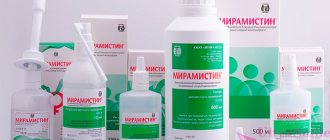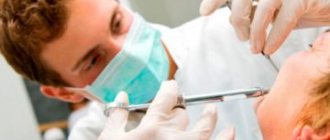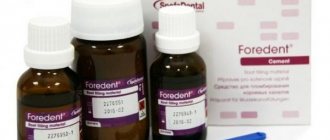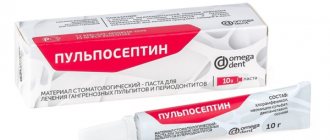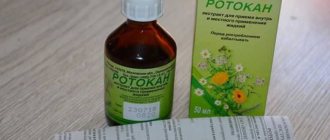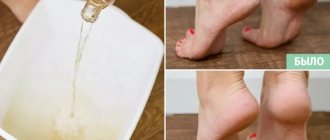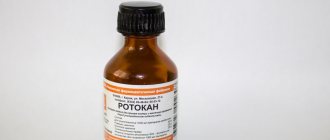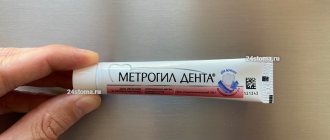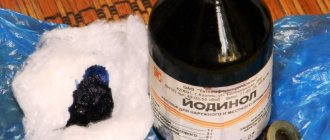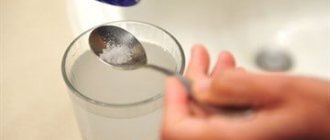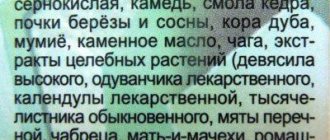Author of the article:
Soldatova Lyudmila Nikolaevna
Candidate of Medical Sciences, Professor of the Department of Clinical Dentistry of the St. Petersburg Medical and Social Institute, Chief Physician of the Alfa-Dent Dental Clinic, St. Petersburg
According to statistics, every second person on the planet has suffered from gum inflammation at least once. It is not surprising: the modern rhythm does not allow us to properly care for the oral cavity; bacteria accumulate between the teeth and begin to actively multiply, which leads to various pathologies.
One of the most popular remedies for gum inflammation is the well-known Miramistin. This powerful solution will quickly destroy harmful bacteria and return you to normal life. But how do you know when it’s time to start rinsing? How to carry out the procedure correctly? Let's figure it out together.
How is the drug released?
There are several different forms of release of the drug. This allows you to choose the most convenient option for use for each individual patient. It is better to rinse your gums with Miramistin in the form of a solution, and, for example, use the ointment during the treatment of herpetic manifestations on the skin.
Solution
One of the most effective and convenient forms of the drug. Proper use allows you to cover the entire inflamed part of the gum or mouth. In addition, the solution can be used not only for rinsing, but also for making lotions and performing douching and wiping. The downside is that it is difficult to use for treating young children, since it is difficult for them to keep the liquid in their mouth and not swallow. For kids, it is better to choose other release options.
Spray
This is the same antiseptic solution, only the packaging is different. A special nozzle on the lid allows you to spray the medicine in hard-to-reach places on the gums, for example, when treating a small child who cannot rinse his mouth on his own. In this method, it is not always possible to cover all problem areas with Miramistin, unlike rinsing, when the entire oral cavity is susceptible to antiseptic influence.
Ointment
Miramistin in the form of an ointment is not used for gum inflammation, since this form is practically not fixed at the site of application, and there is a risk of swallowing the drug. In addition, the components of the ointment affect only the upper balls of the gums, without penetrating into deeper structures, so the therapeutic effect is practically absent. Ointment forms will be appropriate for the treatment of herpetic rashes on the skin.
Scope of application and characteristics of antiseptic
The medicinal and prophylactic drug is an effective antiseptic, ideal for treating the larynx and oral cavity. For these purposes, a solution form is used. Miramistin is a transparent, odorless and colorless liquid preparation. It foams when shaken. Composition of the product:
- benzyldimethyl ammonium chloride monohydrate;
- additional component – distilled water.
To rinse the mouth with Miramistin, the child must be able to gargle. Otherwise, you should use a spray form, irrigating the inflamed mucous membrane of the baby’s throat.
Solution:
- in no case is it absorbed into the mucous membranes;
- does not violate local immunity;
- does not irritate the skin;
- does not affect the functioning of internal organs in any way;
- does not penetrate into blood vessels.
Therefore, Miramistin is used without restrictions in children of different ages and in pregnant women.
Experts recommend gargling with Miramistin for preventive purposes. This can be done once a day during epidemics of acute respiratory infections, acute respiratory viral infections, influenza, or if there is a patient in the house who has already become infected with acute viral or infectious colds. Miramistin will eliminate sore throat and painful sensations.
The product will reduce swelling of the mucous membranes and destroy pathogens:
- sore throats,
- stomatitis,
- tonsillitis,
- laryngitis,
- pharyngitis.
The antiseptic promotes the rapid healing of small wounds in the oral cavity. Preventive rinsing is recommended for children starting from 5 years of age, as well as for adult patients.
The pharmaceutical industry produces medicine in the form of a 0.01% solution, ointment, spray. The medicine is intended for local use.
This drug belongs to the group of antiseptics. To treat the throat and oral cavity, Miramistin is used in the form of a solution that is odorless and colorless, foaming when shaken. The medication consists of the active substance benzyldimethyl ammonium chloride monohydrate and an additional component – distilled water.
The main substance of Miramistin acts directly on the cellular structures of microbes. While destroying and leading to the death of the cells of pathogens, the antiseptic does not have a negative effect on healthy cells.
The medicine is not absorbed through the skin and mucous membranes. The drug does not affect the functioning of internal organs and does not penetrate the bloodstream. Allowed for pregnant women during breastfeeding and children from infancy.
Miramistin has a detrimental effect on pathogenic microorganisms:
- Bacteria of all types (staphylococci, streptococci, gram-negative, anaerobic, aerobic).
- Virulent fungi.
- Human immunodeficiency viruses and viruses that cause herpes.
- Microorganisms that cause diseases that are transmitted through sexual contact.
Miramistin is a broad-spectrum drug that affects pathogens of viral, fungal, and bacterial infections. It is used as an antiseptic in the fight against nosocomial infections. This product activates local immunity and has a regenerative effect on the affected areas.
- When relieving inflammation in the oral cavity, complex treatment of stomatitis caused by a herpetic virus, disinfection of removable dentures is carried out using this drug.
- In the treatment and prevention of purulent inflammatory processes in muscles and bones in surgery and traumatology.
- Used in gynecology and obstetrics to prevent postoperative events.
- Urologists effectively carry out anti-inflammatory therapy with Miramistin for diseases of the urethra.
- The medication is widely used in skin and venereal disease clinics for the treatment of pathological conditions caused by fungi and for the prevention of sexually transmitted diseases.
- Miramistin is prescribed for the treatment of various forms of burns and sanitary treatment of burn lesions before plastic surgery.
- A wide range of diseases of the ear, nose and throat of inflammatory origin are treated with this medicine in otorhinolaryngology.
Despite the wide spectrum of action, Miramistin, due to its medicinal properties, is one of the most effective drugs in the treatment of dental and otolaryngolic pathologies.
Stomatitis
The drug is a broad-spectrum antiseptic, fights all types of bacteria, copes with the herpes virus and Candida fungus, which is why it is so often prescribed in the complex treatment of stomatitis, especially herpetic and candidiasis. However, if you suspect stomatitis, you should not prescribe this medicine to yourself or your child, because it is not always effective. So, with an allergic type of pathology, the remedy will not work, and it is almost impossible to determine without the help of a doctor what type of disease you have developed.
The photo shows stomatitis
How the drug works
This drug is a drug that has a bactericidal effect when applied topically. Numerous studies have proven that the product is effective against most known pathogens of stomatitis - it affects bacteria, pathogenic fungi, and most viruses that can damage the mucous membrane.
At the same time, the active substance of the drug does not interact with the epithelium lining the oral cavity and does not damage the cell structure.
The medicine has a huge advantage - the drug is sold in pharmacies, ready for use, and it can be used as prescribed by a doctor without any additional manipulations. You do not need a prescription to receive Miramistin.
Comments
Miramistin is really good, but it’s just expensive, almost 400 rubles for 150 milliliters. What is the best way to replace it?
Cherkassova Dilyara (09.10.2020 at 23:29) Reply to comment
- Dear Dilyara, in terms of the principle of action and set of positive properties, budget drugs such as Chlorhexidine and Furacilin are similar to Miramistin. But before using them, do not forget to consult your doctor, because they have a number of contraindications.
Editorial staff of the portal UltraSmile.ru (10/13/2020 at 09:14) Reply to comment
Write your comment Cancel reply
How to use Miramistin in dentistry and what contraindications does the drug have?
Miramistin is a pharmacological drug based on benzyldimethyl ammonium chloride.
This substance was developed by scientists from the Soviet Union and was originally planned to be used for surface disinfection of spacecraft and satellites.
But since the 90s, it has been actively used in medicine as an antiseptic with a wide spectrum of action (destroys both bacteria and fungi).
This is interesting: The best teeth whitening products that work
How is Miramistin used in dentistry?
Pros and cons of the drug
The key advantage of Miramistin is that it is active against most gram-positive and gram-negative bacteria, including those resistant to antibiotics, as well as against ascomycete fungi, yeasts, and dermatophytes.
The drug is characterized by an antiviral effect (including against those that cause sexually transmitted diseases).
And at the same time, Miramistin accelerates wound healing and enhances the local immune response (by stimulating phagocytosis).
The active substance is insoluble, therefore drugs based on it are produced in the form of aqueous, alcoholic solutions, ointments, gels and even powder for the preparation of a saturated concentrate (not currently sold).
It does not penetrate the mucous membrane or the upper layer of the epithelium, so it can be used even during pregnancy - this substance is not absorbed into the blood.
Among the disadvantages, one can highlight only the aggressive effect on microflora, which is why it should not be used in dentistry for more than 5-7 days. Otherwise, the concentration of beneficial bacteria on the oral mucosa will significantly decrease, which increases the risk of developing stomatitis.
Indications
According to the official instructions, the indications for the use of Miramistin in dentistry are:
Doctors also recommend using Miramistin for regular hygienic cleaning of removable dentures or after tooth extraction (to speed up wound healing and prevent bacterial damage).
Miramistin can also be used to treat inflammatory diseases, including laryngitis and tonsillitis.
Rules of application
In dentistry, Miramistin is used as a rinse.
It is prepared at the rate of 10-15 milliliters of the drug per 25-40 milliliters of boiled, cooled water.
The mouth is rinsed with this composition 3-4 times a day.
After treating the gums and mucous membranes with Miramistin, you should refrain from drinking, eating and smoking for at least 60-90 minutes (optimally 2 hours). The permissible course of therapy is up to 7 days, then only with the direct prescription of the attending physician.
The medicine is also applied using a tampon to areas of inflammation in the gum area. They are also used to make bandage compresses for treating wounds after tooth extraction - this will speed up the healing process. Such tampons are applied only after the blood clot has “hardened”.
Miramistin can also be used by a doctor to treat the junction of a denture and gums. To do this, a thread soaked in a medicinal solution is placed in the subgingival pocket.
Why do you need to rinse your mouth after tooth extraction?
After the tooth extraction procedure, a hole with damaged blood vessels remains. A blood clot forms in it, protecting the wound from infection. New mucous membrane grows under it, and the periosteum heals. If the clot is accidentally removed or washed out, bleeding may resume. The wound will become vulnerable to various infections. For this reason, complications often develop. Therefore, oral care after tooth extraction should be extremely careful.
Rinsing is prescribed to prevent wound infection and the occurrence of purulent-septic complications. They promote rapid healing of the gums and reduce swelling that is possible after surgery. Only a doctor can tell you whether it is necessary and possible to rinse your mouth after tooth extraction. Trying to treat a wound on your own can be harmful.
Features of use
Miramistin must be spat out after treatment of the oral cavity, but in case of accidental ingestion, there is no need to worry.
People who have been diagnosed with a catarrhal form of gastritis, provoked precisely by an imbalance of the positive microflora of the gastrointestinal tract, should use the solution more carefully.
During dental treatment of teeth, gums or oral mucosa, a burning sensation may occur - this is a normal reaction. You just have to remember that the drug should be used only for local treatment. Accordingly, if it is necessary to act exclusively on a small area of the gum, then it is better to use a tampon rather than completely rinse the oral cavity.
For children
According to the official instructions, Miramistin can be used from 3 years of age.
Pediatricians recommend using it as a spray, that is, spraying it on the mucous membranes of the mouth, gums, and teeth.
Another option is to use a silicone toothbrush soaked in Miramistin (at the rate of 15 milliliters of water and the 0.01% solution itself).
You can buy a special finger brush in pharmacies. Up to 3 years, Miramistin is used only as prescribed by a doctor and under his supervision.
During pregnancy
There are no restrictions during pregnancy regarding the use of Miramistin. But to prevent an allergic reaction, a hypersensitivity test is performed before using it. To do this, apply a few drops of the solution to the skin in the wrist area (where the pulse can be measured) and rub thoroughly.
If no allergic reaction occurs within 10-15 minutes (inflammation, redness, blistering, rash), then Miramistin can be used according to the instructions for use.
During lactation, the use of Miramistin is also allowed.
A few words about the history of the creation of the drug
"Miramistin" as a drug first began to be developed in the distant 70s. At first, it was promoted as a composition that was supposed to be used at interorbital stations to disinfect the skin of astronauts and to treat objects, things, and workplaces around them. However, after the collapse of the USSR, research on the active antiseptic substance miramistin was suspended; they were returned to them again in the late nineties. It was then that the medicine first began to be put on sale, but to solve narrow-profile problems (for example, the prevention of sexually transmitted diseases). There was no talk of him as a child at all.
Miramistin allows you to solve problems in many areas of medicine
Later, additional studies were carried out, which allowed specialists to expand the list of areas of application of the drug. And its safety, almost one hundred percent effectiveness and the absence of contraindications, except for individual intolerance, made it possible to use Miramistin for children.
Today the drug is produced by a production facility located in the Moscow region. The medicine is in demand in Russia, Ukraine, Belarus, Kazakhstan, Turkmenistan, and Armenia. They also plan to sell the product in China soon1.
Now let’s look at the cases in which doctors at dental clinics recommend using the drug. You need to understand that Miramistin is equally often prescribed in both pediatric and adult dentistry as an additional measure to the main treatment. It is not a panacea, but the instructions for its use state that, in combination with other measures, it helps get rid of various problems.
Side effects and contraindications
Side effects from using the drug include the risk of developing an allergic reaction. It occurs very rarely and most often affects young patients. A burning sensation may occur during use. This phenomenon is considered normal and does not require refusal from further use.
Contraindications include individual intolerance of the body to the components of the drug, which occurs in the presence of certain types of allergies and dermatitis. In any case, Miramistin should be taken under the supervision of a specialist.
Features of rinsing your mouth with an antiseptic
Experts recommend gargling with Miramistin for preventive purposes. This can be done once a day during epidemics of acute respiratory infections, acute respiratory viral infections, influenza, or if there is a patient in the house who has already become infected with acute viral or infectious colds. Miramistin will eliminate sore throat and painful sensations. The product will reduce swelling of the mucous membranes and destroy pathogens:
The antiseptic promotes the rapid healing of small wounds in the oral cavity. Preventive rinsing is recommended for children starting from 5 years of age, as well as for adult patients.
Treatment of throat in infants
The instructions for use say that Miramistin is prohibited for use in patients under 12 months of age. This is because the drug has not been tested on infants, and therefore their reaction is unknown. However, many doctors claim that the antiseptic is safe if the dosage and rules of use are followed.
For the treatment of patients under 12 months, an aerosol is often used. This dosage form is the most convenient and safe for infants.
The nebulizer directs the jet precisely to the affected area, while maintaining the appropriate dosage and concentration of the drug. The drops act on individual areas of the mucous membrane, and the spray is evenly distributed over the entire infected area.
The daily dose of Miramistin for the throat is 1 injection 2 times. The decision to increase the frequency of administration is made by the attending physician.
The difficulty of using the drug for newborns up to 12 months is that the baby cannot help the parents and does not understand what is happening. Therefore, adults should adhere to the following recommendations:
- It is necessary to carefully insert the spray into the baby's mouth and irrigate the inner lining of the cheeks or tongue.
- In order for the medicine to penetrate to the source of infection, the spray is applied not to the throat, but to the pacifier. Before the procedure, the pacifier is disinfected, and after irrigation it is placed in the baby’s mouth.
Usually the procedure does not cause stress in newborns, since the medication has a neutral color and odor. The active component is mixed with saliva, penetrates into the site of inflammation, where it begins to act.
It is strictly forbidden to independently increase the dose of medication for children under 1 year of age. This threatens with soreness and drying out of the mucous membrane. In addition, there is a risk of accidental ingestion, after which the functioning of the stomach is disrupted.
Miramistin for the throat exhibits a therapeutic effect already on the second day of use.
How to rinse your mouth with miramistin for gum inflammation?
To rinse, you need to put 15 ml of undiluted Miramistin in your mouth and start the procedure. When rinsing, it is important to ensure that the gums come into contact with the antiseptic. After rinsing, the drug should be spat out.
This is interesting: Factors contributing to the development of caries
Doctors recommend repeating the procedure twice a day for 10 days until the inflammation is eliminated.
Is Miramistin effective for stomatitis?
The drug has antimicrobial and bactericidal properties, destroying gram-negative and gram-positive microflora. Under the influence of Miramistin, the proliferation of fungi is inhibited, stopping the development of the disease. The medicine helps to form an adequate and correct immune response. As a result:
- local immunity significantly enhances its protective properties;
- the infection stops spreading to healthy tissue;
- already damaged tissues are restored faster;
- the drug helps to adsorb (collect) pus and remove waste products of pathogenic microorganisms;
- stops inflammatory processes.
A big advantage of the drug is its good compatibility with other antibiotics that are taken to increase tissue regeneration, as well as the taste of the drug. Many medications that are intended for treating the oral cavity are produced with an unpleasant taste. This becomes a problem when using them for children. Reflex vomiting and increased salivation can create a dangerous situation for the child’s health. Miramistin is distinguished by the absence of antipathetic odors and tastes. The solution is more similar in taste to plain water, which greatly simplifies the procedure for using it for children.
The drug is also suitable for preventive purposes when one of the family members already has the problem. To do this, the oral cavity is sprayed with Miramistin solution 2 times a day, but the drug cannot be used for more than 10 days.
The use of the drug does not always guarantee a positive result in treatment. Miramistin will not bring the expected result for allergic stomatitis. Treatment may fail if the disease is caused by dental problems. These include: the presence of periodontal disease or tartar, advanced caries, as well as the presence of other inflammatory processes. First you need to eliminate the original cause. Then just start fighting stomatitis.
Prevention and treatment of alveolitis after tooth extraction
A rinse solution is used. It is used 2-4 times during the day, the course of administration should not exceed a week, a maximum of 10 days.
Miramistin for a fistula on the gum is prescribed for rinsing the canal, and then for rinsing the entire oral cavity. The frequency of use depends on the severity of the disease, but it is not recommended to use the drug for more than two weeks.
Use for toothache
Often after tooth extraction, the doctor prescribes rinsing with various antiseptic solutions. The primary goal of this procedure is to prevent wound infection. But in addition to this, Miramistin has an anti-inflammatory effect, affecting the symptoms of the pathological process. One of the symptoms of inflammation is pain. The drug also saves from it.
Almost no one prescribes this remedy as a first-line fighter against toothache. In most cases, this is done to prevent the development of this unpleasant syndrome.
In what cases is rinsing with Miramistin prescribed:
- After the retraction. Tooth extraction can be performed against the background of an inflammatory process. The procedure may be complicated due to an inconvenient location in the hole or doctor errors. In such cases, to prevent the development of alveolitis, rinsing with this solution is prescribed. The course lasts up to 10 days, during which time you need to perform oral baths 2-3 times daily.
- In the treatment of gum or periodontal inflammation. Therapy for gingivitis and periodontitis should begin with eliminating the main causes and factors leading to their occurrence. To do this, professional hygiene is initially carried out, after which, ideally, you should give up smoking and other bad habits. Immediately after the procedures, the doctor prescribes a course of rinsing, which may include not only rinsing with the solution in question, but also applying another drug, Cholisal gel.
- In the treatment of stomatitis. Dentists note that this is one of the best remedies for this pathology. It quickly suppresses the activity of viruses, which leads to suppression of their condition and a gradual decline in the disease.
These are the most common oral applications. If the patient has any other indications, the doctor will definitely tell you about it and prescribe a course of this drug.
How to rinse your mouth with Miramistin after tooth extraction
In the first 1–2 days after extirpation, any rinsing is prohibited. Otherwise, you can wash the clot out of the well. If an infection gets into it, alveolitis or osteomyelitis will begin. In the first case, the socket becomes inflamed, in the second – the bone. That's why they only do baths. Take one sip (10–15 ml) of liquid at room temperature into your mouth, hold it for 1–2 minutes and spit it out.
Next, you should adhere to the following rules:
- Starting from the 3rd–4th day, you can carry out gentle rinsing. To do this, you need to tilt your head several times from the side of the extracted tooth to the healthy one.
- Baths and rinses are carried out immediately after meals.
- After treating the oral cavity with Miramistin for 1–1.5 hours (optimally up to two), you should refrain from smoking, drinking and eating.
In most cases, patients are prescribed 3-4 rinses per day. The course of treatment is up to a week.
After tooth extraction, patients should also pay special attention to oral care. If you are concerned about whether it is possible to do ordinary hygienic rinses, then you should also avoid them at first. In order to maintain hygiene, patients are recommended to use the same baths. To do this, take warm water into your mouth, hold it a little and spit it out. And so several times until you feel fresh.
How to use the product correctly?
The best results are achieved by rinsing. At first glance, the rinsing procedure seems quite simple, but not everyone knows the specifics of using Miramistin. An important rule is to follow the prescribed dose, taking into account the patient’s age. Do not forget that this is a medicine, and not a simple medicinal tea.
It is important to strictly follow the instructions for the drug
Sequencing
To achieve the desired effect, you should follow several rules.
| Rule | Description |
| Dosage | Do not under any circumstances exceed the dosage of the drug. Children under 14 years of age need to dilute the liquid with water (2-3 tablespoons). |
| Proper rinsing | While rinsing, you need to tilt your head back slightly. Microorganisms along with the drug can accidentally penetrate the nasal passages, which will only increase the number of existing problems. In the worst case, you can “earn” otitis media. Gargling should be done very carefully. There is no need to blow bubbles, hiss and strain your throat like a small child. This will not increase the effect of Miramistin. When rinsing, try to keep the lower jaw slightly forward. This way, the Miramistin composition will be able to penetrate hard-to-reach places. |
| Swallowing medication | Do not swallow the product after rinsing. A person will not get poisoned this way, but you should not bother your stomach with unnecessary chemicals. The product must be spat out. |
| Storage | You should not store the product in the refrigerator - the storage location should be maintained at room temperature. Half an hour after rinsing, you should not eat or drink water or other liquids. Otherwise, the film of the medicine along with the food will end up in the stomach, and the effect will be zero. You need to wait for Miramistin to begin its anti-virus action, which begins 10 seconds after rinsing. |
| Treatment frequency | It is recommended to rinse your mouth for 2-4 minutes 2-3 times a day. For children, 30-40 seconds will be enough. The treatment course with an antiseptic lasts from 5 to 7 days. If during this period the patient does not notice any improvement, it is worth re-making an appointment with the attending physician to prescribe a new treatment. |
It is important to rinse your mouth correctly
The recommendations are quite simple and will not cause difficulties if you follow them. Do not forget that any microorganisms can adapt to any conditions. At some stage of the disease, the effect of the drug may stop. To prevent this from happening, you should alternate rinsing with an antiseptic and herbal infusions or soda-saline solution.
Dissolve 3 potassium iodine and 1 tsp in 1 glass of warm purified water. soda and salt. Stir everything well and leave to infuse for 15 minutes, after which you can use the product for its intended purpose.
Infusions of sage or chamomile also do not conflict with Miramistin. Alternating them will help achieve the desired result.
This is interesting: Is it possible to do ultrasonic teeth cleaning for pregnant women: possible harm to the hygiene procedure
You can alternate rinsing with Miramistin and herbal infusions
Recommendation ! Along with the antiseptic, a special nozzle should come in the package. You can also purchase a dropper, but it is usually difficult to capture the required amount of liquid. As an alternative, a regular spoon will do. Using these devices, it will be easy to determine the correct dosage.
What else can you use?
An effective alternative to Miramistin can be Asepta Active mouth rinse. This remedy combines a combination of anti-inflammatory, analgesic components, benzydamine and the antimicrobial component chlorhexidine.
This composition complements the antiseptic effect of the mouthwash by quickly relieving pain, which significantly increases the effectiveness and speed of treatment of gum inflammation.
Chlorhexidine
A 0.05% aqueous solution is used to rinse the mouth .
Directions for use: take 1 tablespoon of the product into your mouth, rinse for 1 minute 2 times a day (preferably morning and evening), about one hour before brushing your teeth.
Treatment time is no more than 10 - 12 days. The medicine is not diluted. You need to rinse continuously for a minute.
An excellent remedy that has high antimicrobial activity and copes well with painful sensations.
When can you rinse with Novocaine?
For pain relief, a medicinal solution is used with a percentage of anesthetic from 0.25% to 2% in ampoules or bottles.
To prepare a rinse solution you need to take 200 ml of novocaine, the white of one egg, 1 teaspoon of salt. Mix everything. The resulting mixture must be kept in the mouth, in the place of discomfort. Repeat several times until the pain goes away.
Important! Under no circumstances should you swallow the solution.
Novocaine has a weak analgesic effect. It has a slight effect on inflammatory processes in tissues. Very toxic and causes allergies.
How to take other medications: Furacilin, Chlorophyllipit
Furacilin is a ready-made solution for rinsing based on sodium chloride, the concentration of which 0,002 %.
Use the product up to 5 times a day. Hold in mouth for 2 - 3 minutes , then spit out. The composition can be used for up to 10 days.
Before starting the procedure, you should rinse your mouth with soda solution to achieve the best effect.
Furacilin is an excellent antiseptic with a slight analgesic effect.
Chlorophyllipt is an antimicrobial agent based on natural eucalyptus.
A diluted alcohol solution is usually used to irrigate the oral cavity. The product is not used in its pure form, since there is a risk of burns on the mucous membrane.
Important! The drug should be taken with great caution, as its action causes an allergic reaction.
Chlorophyllipt has a mild effect on pain.
Rotokan
Rotokan is an alcohol tincture consisting of medicinal plants: calendula, chamomile and yarrow.
dissolve a teaspoon ( 5 ml in 1 glass (200 ml) of warm water. Rinse for 2 - 3 minutes, several times a day. The course of treatment is from 2 to 5 days.
Important! Do not use alcohol tincture undiluted.
Rotokan is quite suitable for pain relief and disinfection.
Stomatophyte
Stomatophyte is an anti-inflammatory agent, a liquid extract consisting of 7 different medicinal plants.
Photo 1. The drug Stomatofit in a 50 ml bottle is an anti-inflammatory agent for the oral cavity, consisting of seven medicinal plants.
The rinse solution is prepared as follows: 7.5 ml of extract is diluted in 1/4 cup of warm water. The procedure is carried out several times. The course of treatment is about two weeks . Repeated treatment is possible only as prescribed by the dentist.
Stomatophyte is a good medicine, but its anti-inflammatory effect is insignificant, so the relief of pain is weak.
In what cases are rinses ineffective?
Knowing what to rinse your mouth with when your gums are inflamed is not enough to cure their inflammation. Various mouth rinses (even the strongest ones), as well as various gels for gums, are only auxiliary means, and will never be able to cure inflammation on their own once and for all. There are 2 main types of gum inflammation – gingivitis and periodontitis. Gingivitis is the initial stage of inflammation, the main symptoms of which are: swelling, redness or bluishness of the gums, pain and bleeding when brushing teeth, bad breath. With periodontitis, these symptoms are accompanied by mobility of teeth, suppuration from periodontal pockets, atrophy (destruction) of the bone tissue around the teeth.
The causes of the development of gingivitis and periodontitis are soft microbial plaque, as well as hard supra- and subgingival dental deposits. In fact, the main cause of inflammation is insufficient oral hygiene. Antiseptic rinses are actively used to treat gum inflammation, but they are only an aid. The main treatment, after all, is the removal of dental plaque by a dentist, after which, ideally, a course of gum treatment is carried out.
If dental plaque has not been removed, and you have started using antiseptic rinses and anti-inflammatory gels, the symptoms of inflammation will certainly decrease for some time. But the inflammation will certainly gradually return again as soon as you finish the course of rinses and applications. The danger of using anti-inflammatory rinses and gels in this case is that they only mask the symptoms of the disease (and the inflammation progresses unnoticed).
In complex therapy for the treatment of gum diseases, you can use not only rinses and gel applications, but also special anti-inflammatory toothpastes for gums, which will very quickly help you reduce bleeding and swelling of the gums. Some of these pastes are also suitable for long-term prevention of inflammation.
Inflammation of periodontal tissues
The drug is used for antiseptic treatment of the oral mucosa during the treatment of gingivitis, periodontitis and periodontal disease. In combination with other measures (for example, taking antibiotics, brushing teeth from plaque and tartar, plasma lifting and injections of hyaluronic acid, bioactive gels), the product helps relieve inflammation and swelling of tissues, get rid of bleeding and increased sensitivity of the gums.
The drug is used for periodontitis
Miramistin: analogue
When you find out how much Miramistin costs, you really want to find something cheaper. It’s a pity, but the drug Miramistin does not have an analogue. However, Miramistin is indispensable only for the treatment of herpetic stomatitis, and as for the treatment of the throat, gums, and skin wounds, there is a good alternative.
- If you need an antiseptic without an antiviral effect, a 0.05% Chlorhexidine solution is perfect. After all, in fact, a rinse solution with an antiviral effect is needed exclusively for diseases of viral origin, for example, with the herpetic form of stomatitis.
- For inflammation of the gums and for the treatment of the throat - as in the previous case, antiviral activity is not needed here, but only a pronounced antimicrobial effect is needed. Therefore, the announced drug will be very effective for this pathology. Moreover, Chlorhexidine is also produced in the form of a spray, which is most convenient in the treatment of tonsillitis, etc.
Miramistin or chlorhexidine: what is the difference
The antimicrobial activity of Miramistin against most pathogenic bacteria is very high, but it is slightly lower than that of Chlorhexidine. The only significant advantage of Miramistin over Chlorhexidine is that it is effective against herpes viruses and therefore it can be used for the herpetic form of stomatitis (but if you do not have stomatitis at all, or any other form of stomatitis, then this does not matter).
However, if you need an antiseptic for the youngest patients, then you need to take into account that Chlorhexidine has a bitter taste, and is usually not liked by small children. In addition, when using Chlorhexidine, temporary darkening of the teeth and tongue is possible due to staining of bacterial plaque. But if there is no plaque on the teeth, then their staining will not occur.
Important: however, Chlorhexidine benefits not only due to its slightly higher antimicrobial activity. The most important thing is that after rinsing or irrigating with this antiseptic, a thin film of Chlorhexidine remains on the surface of the mucous membrane, which lasts for several more hours. Miramistin does not have such an effect.
Thus, miramistin or chlorhexidine, which is better, will depend on the form of the disease, the age of the patient and the cost you are willing to pay. After all, Chlorhexidine is also much cheaper - from 20 rubles for a solution and about 60 rubles for a spray (100 ml volume).
Indications for use of Miramistin
Rinsing is often prescribed in the following cases:
- before extirpation (removal) of the tooth, inflammation (pulpitis, periodontitis) was diagnosed;
- the gums were additionally injured (for example, the gumboil was opened, drainage was installed to remove pus);
- There are sources of infection in the oral cavity (carious teeth, stomatitis, tartar, inflammation of the gums, etc.).
These factors significantly increase the risk of wound infection. You can prevent it by knowing how to rinse your mouth. This disinfects the hole, destroys pathogenic microflora, so the likelihood of developing complications is reduced. The main rule is that rinsing should not be too intense. Additionally, the doctor may prescribe antibacterial and anti-inflammatory non-steroidal drugs.
Rinsing is often useful after wisdom tooth removal, since the procedure is traumatic. Eights grow normally only 20% of the time. In 8 out of 10 patients, wisdom teeth are removed at the eruption stage. Due to the peculiarities of their incorrect placement, the tissues are severely damaged, so the recovery period is delayed. Rinsing allows you to speed it up.
